Exploring the Intricacies: Inside the Hemp Production Process
Welcome to our in-depth exploration of the hemp production process. In this article, we will delve into the various stages involved in cultivating, harvesting, and processing hemp. From understanding the optimal harvest window to choosing the right harvesting method, we will uncover the intricacies that contribute to the production of high-quality hemp. Join us on this journey as we unravel the secrets of this versatile and sustainable crop.
Key Takeaways:
- Hemp cultivation involves determining the ideal harvest window for maximum cannabinoid content.
- Hand harvesting allows for a selective approach, while machine harvesting is more efficient for larger operations.
- Drying and curing are essential steps to preserve cannabinoids and terpenes after harvest.
- The regulatory landscape for hemp production is complex and requires uniformity for industry growth.
- The future of hemp holds promise for various sectors, including textiles, construction, and health and wellness.
Timing is Everything: Understanding the Harvest Window
Determining the right time to harvest hemp involves a delicate balance between the maturity of the plant and the environmental conditions. It is crucial to harvest when the flowers are fully developed but not yet past their prime. This stage is when the cannabinoid content, including CBD, is at its highest. Timing the harvest correctly is essential to ensure the quality of the final hemp product.
The harvest window varies depending on the specific strain and intended use of the hemp. The ideal time to harvest is typically determined by observing the trichomes on the flowers. Trichomes are small, resinous glands that house the cannabinoids and terpenes. When the trichomes transition from a clear or translucent color to a milky or amber hue, it indicates that the hemp is nearing its peak cannabinoid content. This visual cue helps farmers make informed decisions on when to harvest their hemp plants.
Factors such as geographical location, climate, and intended end products also play a role in determining the harvest window. For example, hemp cultivated for CBD production is typically harvested earlier to capture a higher CBD content. In contrast, hemp grown for fiber or seed may be allowed to mature further to maximize the yield and quality of these specific components.
| Factors Influencing Harvest Timing | Recommendations |
|---|---|
| Strain and genetics | Consult strain-specific guidelines or seek advice from experienced growers. |
| Intended use (CBD, fiber, seed, etc.) | Research optimal harvest windows for specific end products. |
| Environmental conditions | Consider regional climate and weather patterns. |
| Trichome observation | Monitor trichome color changes to determine peak cannabinoid content. |
| Harvest equipment availability | Coordinate with equipment availability and labor resources for efficient harvesting. |
“Timing the harvest correctly ensures that we capture the hemp plants at their cannabinoid-rich peak. It's a meticulous process that requires careful observation of the trichomes and consideration of various factors. By understanding the harvest window, we can optimize the quality and potency of our hemp harvest.”
Hand vs. Machine Harvesting: Pros and Cons
When it comes to harvesting hemp, there are two primary methods: hand harvesting and machine harvesting. Each method has its own advantages and disadvantages, and the choice depends on the scale of cultivation and the specific needs of the operation.
The Selective Approach of Hand Harvesting
Hand harvesting involves manually cutting and collecting the hemp flowers. This method is often preferred by smaller farms that prioritize quality control and meticulousness. With hand harvesting, growers can selectively choose only the prime flowers, ensuring a higher quality end product. This approach allows for careful inspection and removal of any undesirable plant material.
However, hand harvesting is a labor-intensive process. It requires a significant workforce to manually harvest the plants, which can be time-consuming and costly. Additionally, hand harvesting may not be feasible for large-scale operations due to the sheer volume of plants that need to be harvested.
The Efficiency of Machine Harvesting
Machine harvesting, on the other hand, offers efficiency and speed. With the use of specialized equipment, such as combine harvesters, large quantities of hemp can be harvested in a shorter amount of time. This method is well-suited for larger operations that require quick and efficient processing.
However, machine harvesting comes with its own set of challenges. Careful calibration of the equipment is necessary to prevent damage to the delicate flowers and ensure optimal results. The machinery must be adjusted to the specific needs of the hemp plants, taking into account factors such as plant height and density. Without proper calibration, there is a risk of damaging the flowers or losing valuable plant material.
“Hand harvesting allows for a more selective approach, ensuring only the prime flowers are collected.”
| Hand Harvesting | Machine Harvesting |
|---|---|
| Selective approach | Efficient processing |
| Labor-intensive | Requires careful calibration |
| Higher quality control | Quicker and larger volume |
Drying and Curing: Preserving Quality
After the hemp harvest, the next crucial step in the production process is drying and curing the plants. These steps are essential to maintain the quality of the hemp and preserve its valuable cannabinoids and terpenes. Proper drying and curing techniques ensure that the final product is free from mold and has a well-preserved profile of therapeutic compounds.
Hemp drying involves removing excess moisture from the plants to prevent mold growth. The harvested hemp flowers are spread out in a well-ventilated area with controlled humidity levels. This allows the moisture to evaporate gradually without overheating the plants. Rapid drying methods, such as using high heat or direct sunlight, can degrade the cannabinoids and terpenes, leading to a lower-quality product.
Once the hemp flowers are dried, they go through the curing process. Curing involves storing dried hemp in a controlled environment with specific humidity levels. This allows the flowers to continue developing their flavor and aroma profile. Curing also helps break down chlorophyll and other compounds that can contribute to a harsh taste. The result is a smoother and more enjoyable hemp product.
“Proper drying and curing techniques ensure that the final product is free from mold and has a well-preserved profile of therapeutic compounds.”
Drying and Curing Best Practices
To ensure the highest quality hemp, it is important to follow these best practices for drying and curing:
- Avoid rapid drying methods that use high heat or direct sunlight.
- Choose a well-ventilated area with controlled humidity levels for drying.
- Monitor the temperature and humidity regularly during the drying process.
- Store the dried hemp in a controlled environment with specific humidity levels for curing.
- Allow the hemp to cure for at least a few weeks to develop optimal flavors and aromas.
By following these practices, hemp producers can ensure that their dried and cured hemp maintains its quality and delivers a more enjoyable experience for consumers.
| Benefits of Proper Drying and Curing | Effects of Improper Drying and Curing |
|---|---|
| Preserves the cannabinoids and terpenes | Loss of cannabinoids and terpenes |
| Reduces the risk of mold and microbial contamination | Potential mold growth and contamination |
| Develops smoother flavors and aromas | Harsh taste and unpleasant aroma |
| Improves the overall quality of the hemp product | Lower-quality product with diminished therapeutic potential |
Proper drying and curing techniques are critical steps in the hemp production process. By following best practices and ensuring optimal conditions, producers can preserve the quality, potency, and therapeutic properties of the harvested hemp, delivering a superior product to consumers.
Immersive Experiences: Joining the Harvest Event
If you're looking for a hands-on experience in the world of hemp cultivation, look no further than Obelisk Farm's upcoming hemp harvest event. This exclusive event, scheduled for September 3rd, offers a unique opportunity to delve into the intricacies of hemp production and gain valuable cultivation insights.
During the event, participants will have the chance to witness the culmination of months of hard work and dedication in the hemp industry. You'll get to see firsthand the harvest process, from the moment the plants are carefully harvested to the drying and curing stages that ensure the preservation of cannabinoids and terpenes.
Attending the Obelisk Farm hemp harvest event was a truly remarkable experience. It provided a deep understanding of the art and science behind hemp cultivation. From hand harvesting to the meticulous drying and curing processes, I gained a newfound appreciation for the craftsmanship involved in producing top-quality hemp.
Joining the harvest event not only offers a memorable and educational experience but also provides a platform for networking and connecting with like-minded individuals in the industry. Whether you're a newcomer with a budding interest in hemp or an experienced cultivator looking to expand your knowledge, this event offers a unique opportunity to immerse yourself in the world of hemp cultivation.
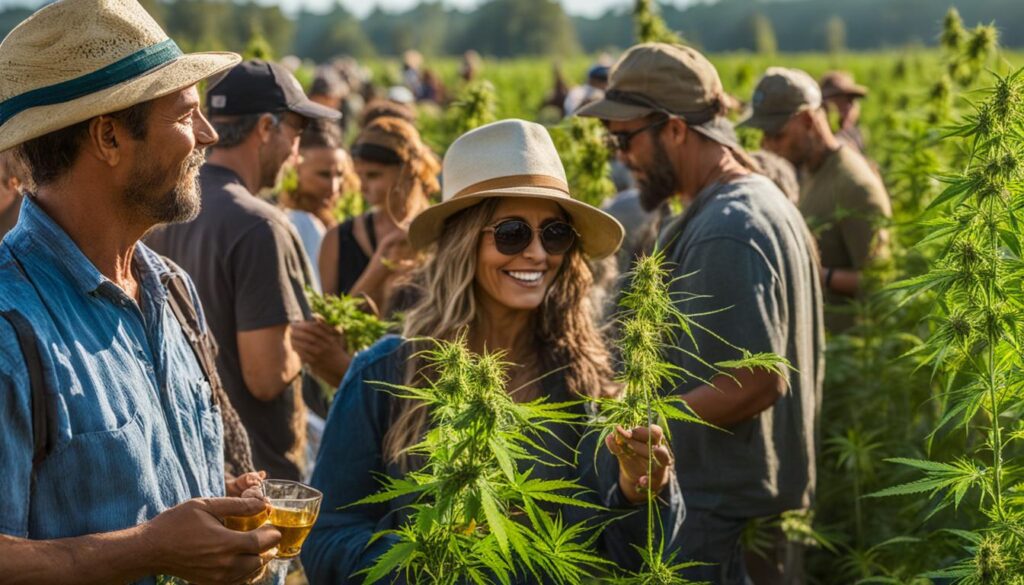
Table: Harvest Event Details
| Date | Time | Location |
|---|---|---|
| September 3rd | 10:00 AM – 4:00 PM | Obelisk Farm, 123 Hemp Street |
| September 4th | 10:00 AM – 4:00 PM | Obelisk Farm, 123 Hemp Street |
| September 5th | 10:00 AM – 4:00 PM | Obelisk Farm, 123 Hemp Street |
Don't miss out on this extraordinary opportunity to gain valuable insights into the world of hemp cultivation. Secure your spot at the Obelisk Farm hemp harvest event and get ready for an immersive experience like no other.
The Complex Hemp Regulatory Landscape
The reintroduction of hemp into the US agricultural sector has been complex due to its association with cannabis and the inconsistencies in hemp regulations. The 2014 Farm Bill laid the groundwork for hemp production, but there have been discrepancies between state and tribal hemp production plans. The 2018 Farm Bill attempted to clarify the regulatory framework but created further inconsistencies. Uniformity and consistency are needed in the regulatory framework to ensure the growth and development of the hemp industry.
State-level Regulations vs. Federal Oversight
The regulatory landscape for hemp production is a patchwork of state-level regulations and federal oversight. While the federal government provides oversight, it allows individual states to develop their own hemp production plans. This decentralized approach has led to inconsistencies between regulations, creating challenges for producers and businesses operating across state boundaries.
“The conflicting regulations have created a complex environment for hemp producers, who must navigate differing rules and requirements depending on the state they operate in.”
Inconsistencies and Challenges
Inconsistencies in hemp regulations can create confusion and hinder the growth of the industry. Producers may face obstacles such as differing licensing requirements, testing standards, and restrictions on THC levels. These discrepancies can make it difficult for businesses to operate efficiently and for consumers to have access to consistent and high-quality hemp products.
The Path to a Cohesive Regulatory Framework
To establish a more cohesive and sustainable hemp industry, there is a need for greater uniformity in hemp regulations. Efforts should be made to align state and federal regulations, ensuring consistent standards and requirements across the country. This cohesive regulatory framework would provide clarity for producers, promote consumer confidence, and facilitate the growth of the hemp industry as a whole.
The Challenges of Hemp Production Research
Research on hemp production has encountered various obstacles, primarily due to legislative restrictions. Initially, many states prohibited research on cannabis due to its association with the psychoactive compound THC. Separate legislation had to be passed to enable research on hemp, which resulted in significant delays. It took several years for these laws to be established, hindering the progress of scientific studies on hemp.
Another challenge in hemp production research is the separation of hemp and cannabis. While hemp contains trace amounts of THC, it has significantly lower levels than marijuana. However, this distinction was not always recognized, and researchers faced difficulties in obtaining the necessary permits and funding for hemp-focused studies. The misconceptions regarding hemp's association with THC hindered the exploration of its potential benefits.
The inconsistencies between federal and state regulations have further complicated hemp research efforts. Although the 2018 Farm Bill legalized hemp at the federal level, individual states maintain their own regulations. This fragmented regulatory landscape creates challenges for researchers aiming to conduct multi-state studies or collaborate across different regions. Greater harmonization and clarity in hemp regulations are essential to facilitate research and unlock the full potential of this versatile crop.
Table: Obstacles in Hemp Production Research
| Obstacle | Description |
|---|---|
| Legislative Restrictions | State laws initially prohibited research on cannabis, including hemp, due to its association with THC. |
| Separation of Hemp and Cannabis | Misconceptions about hemp's association with psychoactive effects hindered research efforts. |
| Inconsistencies in Regulations | Differences between federal and state regulations created challenges for multi-state research and collaboration. |
In conclusion, conducting research on hemp production has faced significant challenges, including legislative obstacles and misconceptions surrounding hemp's association with THC. The separation between hemp and cannabis made it difficult for researchers to obtain permits and funding for studies. Inconsistencies between federal and state regulations further complicated research efforts. The hemp industry needs cohesive and harmonized regulations to support scientific exploration and fully unleash the potential of this remarkable plant.
Overcoming Stigma: The Perception of Hemp
The perception of hemp carries a significant amount of stigma, especially surrounding its association with CBD and THC. Misconceptions and lack of understanding persist in some parts of the country, leading to hesitation and resistance towards embracing hemp and its potential benefits. One of the main misconceptions is the belief that hemp products can make people high, like marijuana. However, it's important to note that hemp-derived products, such as CBD, are typically THC-free, meaning they do not have psychoactive effects.
To overcome this stigma, education and awareness are crucial. By providing accurate information and dispelling misconceptions, we can promote a better understanding of hemp and its non-psychoactive properties. This can be achieved through public outreach programs, educational campaigns, and industry initiatives. As people become more informed about the true nature of hemp and its potential uses, the stigma surrounding it can gradually diminish.
We must highlight the numerous benefits of hemp and its potential contributions to various industries. Hemp is a sustainable crop that requires fewer resources than traditional crops and has a lower environmental impact. It can be used in the production of textiles, building materials, and CBD products, among others. By embracing the rewards of hemp, we can tap into its full potential and contribute to a more sustainable and eco-friendly future.

Overcoming the stigma surrounding hemp is necessary for the growth and development of the hemp industry. Through education, awareness, and highlighting the benefits of hemp, we can reshape public perception and promote the use of this versatile and sustainable crop.
The Constant Evolution of Hemp Regulations
The hemp industry operates within a regulatory framework that is continuously evolving. State-level legislation plays a significant role in shaping these regulations, with federal oversight providing a broader framework for consistency. This decentralized approach has resulted in inconsistencies between regulations, creating challenges for producers and businesses operating across state boundaries.
State-level legislation allows individual states to develop their own hemp production plans, which can vary in their requirements and restrictions. While this allows states to tailor regulations to their specific needs and the preferences of their constituents, it also creates a patchwork of rules that can be difficult to navigate for those in the industry.
“The constant evolution of hemp regulations presents both opportunities and challenges for stakeholders in the industry. While it allows for flexibility and adaptation to changing circumstances, it also requires careful monitoring and compliance with shifting requirements.”
Uniformity in regulations is needed to establish a more cohesive and sustainable hemp industry. This can be achieved through increased collaboration between state and federal authorities, as well as ongoing dialogue among industry stakeholders. By working together, we can create a regulatory environment that fosters growth and innovation while ensuring consumer safety and product quality.
The Benefits of Uniform Hemp Regulations
Uniform hemp regulations offer several advantages for the industry and all those involved:
- Consistency: Uniform regulations provide clarity and predictability for businesses, enabling them to plan and operate across different states more effectively.
- Market Access: Standardized regulations make it easier for hemp producers to access interstate and international markets, fostering economic growth and job creation.
- Efficiency: Harmonized regulations streamline compliance efforts, reducing administrative burdens and costs for businesses.
- Consumer Confidence: Clear and consistent regulations enhance consumer confidence in hemp products, ensuring their safety and quality.
By advocating for uniform hemp regulations, we can support the growth and development of the industry, unlock its full potential, and contribute to a thriving and sustainable hemp economy.
The Future of Hemp: Potential and Promise
The hemp industry is poised for significant growth and boasts immense potential for economic impact. As regulations become more streamlined and consistent, the industry can flourish, leading to job creation and economic opportunities. The versatility of hemp allows it to be utilized in various sectors, including textiles, construction, and health and wellness, further bolstering its potential for growth.
With ongoing research and education, the future prospects for hemp are promising. As more people become aware of the benefits and sustainability of hemp, the demand for hemp products is expected to increase. This growth in demand will drive further innovation and advancements in the hemp industry, opening up new possibilities and markets.
To capitalize on the potential of the hemp industry, it is crucial to invest in research and development. Continued research will enable us to unlock even more applications for hemp, making it a valuable resource for multiple industries. Additionally, investing in sustainable farming practices and organic hemp production will ensure the long-term viability of the industry while minimizing its environmental impact.
As we move forward, it is important to support the growth of the hemp industry through favorable regulatory frameworks and public education. By removing stigmas and misconceptions surrounding hemp, we can foster an environment that allows for the full realization of its potential. By embracing hemp and its sustainable farming practices, we can contribute to a greener future and create a more environmentally friendly and economically prosperous society.
Embracing the Rewards of Hemp
Hemp offers a multitude of benefits that make it a valuable resource worth embracing. One of the key advantages of hemp is its contribution to sustainable farming practices. Unlike traditional crops, hemp requires fewer pesticides and herbicides, making it an environmentally-friendly choice. Additionally, hemp has a natural resistance to pests and diseases, reducing the need for chemical intervention. By incorporating hemp into agricultural practices, we can promote sustainable farming methods and minimize the negative impact on the ecosystem.
What sets hemp apart is its versatility, which allows for a wide range of applications across various industries. From textiles to building materials, hemp fibers offer durability, breathability, and insulation properties. Hemp seeds are a rich source of nutrition, packed with essential fatty acids, protein, and minerals. In the health and wellness sector, hemp-derived CBD products provide natural alternatives for pain relief, relaxation, and skincare. Embracing the versatility of hemp opens up a world of possibilities for innovative and sustainable solutions.
Hemp farming promotes sustainable agricultural practices.
As we embrace the rewards of hemp, it's essential to continue educating and raising awareness about its advantages. By dispelling misconceptions and highlighting the benefits of hemp, we can overcome the stigma surrounding this remarkable crop. Furthermore, supporting research and development efforts in hemp can lead to further discoveries and expand its applications in various industries. Through collaboration and a shared commitment to sustainability, we can tap into the full potential of hemp and contribute to a greener and more environmentally-conscious future.
Conclusion
Throughout this article, we have delved into the intricate world of hemp production. We have explored various aspects of the process, including cultivation techniques, harvesting methods, and processing steps. Understanding the harvest window and selecting the right time to harvest hemp is crucial for obtaining optimal cannabinoid content. Whether it's hand harvesting for smaller farms or machine harvesting for larger operations, each method has its pros and cons. Additionally, proper drying and curing play a vital role in preserving the quality of cannabinoids and terpenes.
However, it's not just about the production process; we have also highlighted the challenges that the hemp industry faces. Regulatory inconsistencies and stigma around hemp still exist, hindering its growth and potential. Overcoming these obstacles is essential to promote organic and sustainable hemp farming practices. By embracing hemp and investing in ongoing research and education, we can unlock its vast potential in various industries.
As we conclude this journey into the world of hemp, we are reminded of the exciting possibilities that lie ahead. With a focus on best practices and sustainable farming, we can create a thriving hemp industry. By supporting the manufacturing process of organic hemp and gaining industry insights, we contribute to a more environmentally friendly future. Let us continue to explore the vast potential of hemp and strive for a more sustainable and eco-friendly world.
FAQ
What factors determine the ideal time to harvest hemp?
The ideal time to harvest hemp is determined by a balance between the maturity of the plant and environmental conditions. Harvesting is typically done when the flowers are fully developed but not yet past their prime.
What are the different methods of harvesting hemp?
There are two main methods of harvesting hemp: hand harvesting and machine harvesting. Hand harvesting allows for a more selective approach, ensuring only the prime flowers are collected, while machine harvesting is efficient for larger operations.
What are the essential steps in the drying and curing process after harvest?
After harvest, the essential steps in the drying and curing process include proper drying to prevent mold growth and ensure the preservation of cannabinoids and terpenes. Curing involves storing dried hemp flowers in a controlled environment with specific humidity levels to develop smoother flavors and a well-rounded cannabinoid profile.
How can I learn more about the hemp harvest process?
You can learn more about the hemp harvest process by participating in immersive events like the upcoming hemp harvest event at Obelisk Farm on September 3rd. This event offers the opportunity to learn about hemp cultivation and explore the potential of this remarkable plant.
What are the challenges associated with hemp regulations?
Hemp regulations have faced challenges due to discrepancies between state and federal regulations. The lack of uniformity and consistency in the regulatory framework creates difficulties for producers and businesses operating across state boundaries.
What challenges have researchers faced in studying hemp?
Researchers studying hemp have faced challenges, including legislative obstacles and discrepancies between federal and state regulations. Some states initially did not allow research on cannabis, requiring separate legislation to enable hemp research.
What is the perception of hemp and its association with CBD?
There is still a significant amount of stigma surrounding hemp, especially around its association with CBD and THC. Misconceptions about hemp products, such as their ability to make people high, persist. Education and awareness are crucial in dispelling these misconceptions and promoting the benefits of hemp.
How are hemp regulations evolving?
Hemp regulations are continuously evolving, with state-level legislation playing a significant role. While the federal government provides oversight, allowing states to develop their own hemp production plans has resulted in inconsistencies between regulations. Uniformity in regulations is needed for a more cohesive and sustainable hemp industry.
What is the future potential of the hemp industry?
The hemp industry has immense potential for growth and economic impact. As regulations become more streamlined and consistent, the industry can flourish. With ongoing research and education, hemp could become a valuable resource for various sectors, including textiles, construction, and health and wellness.
What are the rewards of embracing hemp?
Embracing hemp offers numerous benefits. Hemp is a sustainable crop that requires fewer resources than traditional crops and has a lower environmental impact. Its versatility allows for a wide range of applications, from textiles to building materials and CBD products, contributing to a more sustainable and eco-friendly future.
Source Links
- https://www.obeliskfarm.com/blog/params/post/4338884/dive-into-the-hemp-harvest-experience
- https://jcannabisresearch.biomedcentral.com/articles/10.1186/s42238-023-00181-0
- https://www.buzzsprout.com/2117953/13861256
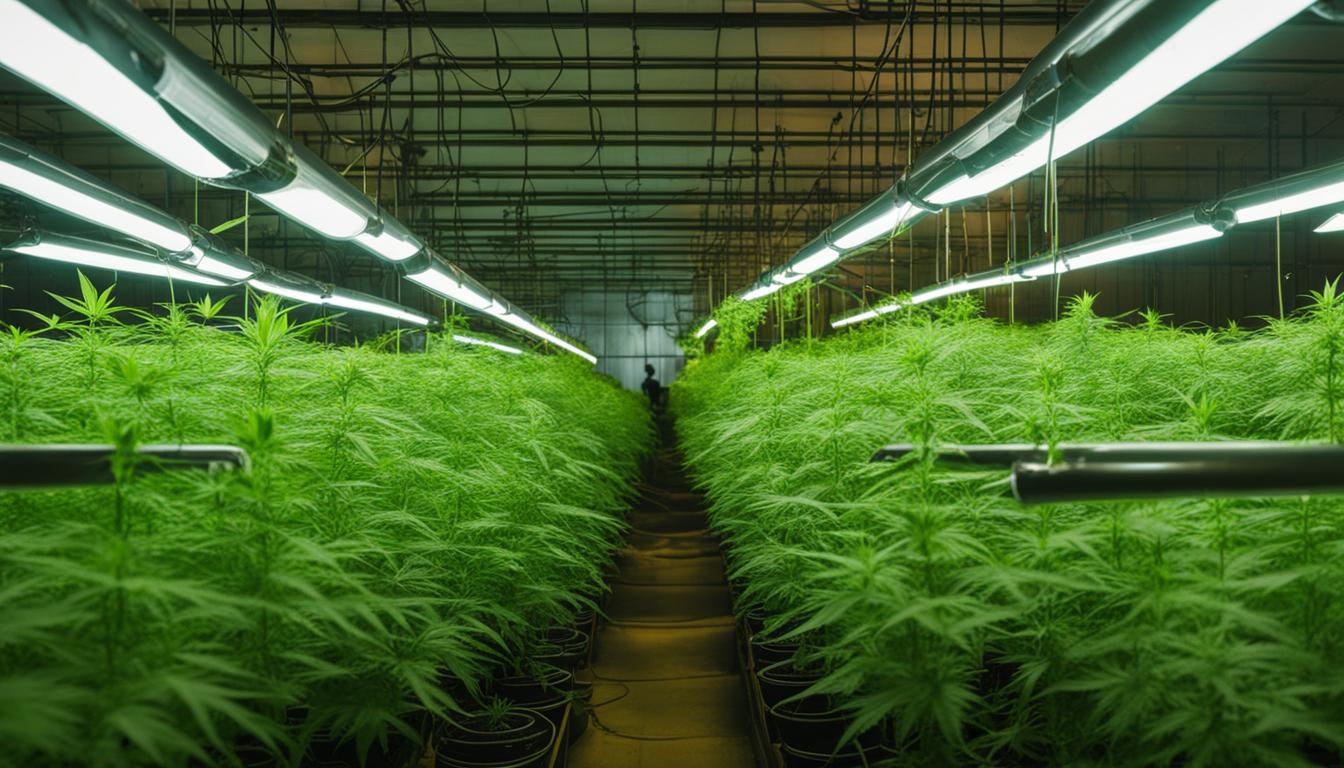
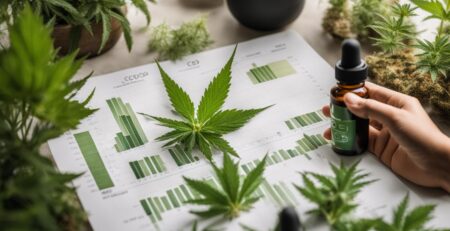

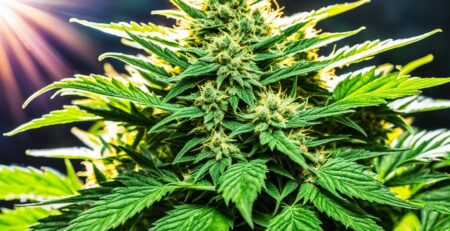




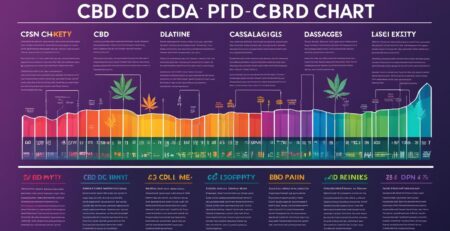
Leave a Reply